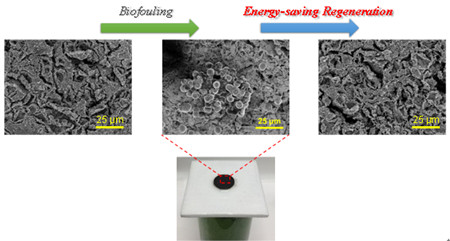Perovskite oxide has unique photoelectric and catalytic activity, and has broad application prospects in the fields of high temperature catalysis, gas separation and photocatalysis. The Membrane Separation and Catalysis Research Group of the Qingdao Institute of Bioenergy and Processes, Chinese Academy of Sciences has carried out a lot of work in the development of new perovskite oxides and their catalytic-membrane separation performance research. Recently, Wang Yuchao, associate researcher of the research group, adopted a perovskite oxide La0.7Sr0.3CoO3 (LSCO) porous membrane, which can not only promote efficient sunlight-driven water evaporation, but also catalyze the degradation of biological pollutants, and realize the energy-saving regeneration of porous membranes . Biological pollutants such as algae and a wide variety of organic pollutants often exist in natural waters. In the evaporation process driven by sunlight, pollutants will be enriched and grown in the photothermal film, resulting in film pollution, resulting in a decrease in the performance of the film material. High temperature degradation can effectively remove biological and organic pollutants, and is an ideal means to achieve membrane regeneration. However, the thermal decomposition process of pollutants requires higher temperatures, resulting in huge energy consumption. Reducing the combustion decomposition temperature of pollutants can effectively reduce energy consumption, achieve energy-saving regeneration of membrane materials, and promote the application of photothermal materials in actual water environments. The head of the research group and researcher Jiang Heqing proposed to use both the catalytic and photothermal properties of cobalt-based perovskites to develop a multi-functional perovskite oxide porous membrane. In the test using algae and melamine as pollutants, the LSCO porous membrane significantly reduced the combustion decomposition temperature of the pollutants attached to it, and reduced the energy consumption of the porous membrane regeneration during the combustion process, achieving the purpose of energy conservation and regeneration. Due to the high thermal stability of the perovskite oxide porous membrane, performance can be almost completely restored after multiple membrane regeneration cycles. This work skillfully utilizes the photothermal and catalytic properties of perovskite oxides to solve the biological pollution problem of photothermal films in practical applications. The research work was supported by the National Natural Science Foundation of China and the Natural Science Foundation of Shandong Province. Related research results have been published in the journal Nano Energy (Nano Energy, 2020, 70, 104538).
We have 2 types of Large Diameter Hose: Frac Hose and Layflat Hose.
Frac hoses were produced through-the-weave, easy cleaning and no drying required.
Designed for long service life. Tough and durable with exceptional resistance to abrasion
And cutting for use on wide variety of environment conditions.
Protected against mechanical damages.
Very low elongation (compared with vulcanized process) under pressure, prevents hose from [snaking".
High resistance to heat, fuels, chemicals, UV, ozone, weathering,hydrolysis,and microbiological attack.
Tube & cover: thermoplastic, polyurethane (TPU)
Reinforcement: High tenacity polyester filament, circular weaving.
The special extrusion through-the-weave process gives a very strong bonding between cover and lining as well as firmly encapsulation the woven polyester.
Temperature range from -50℃ to +70℃.
We can supply frac hoses with size: 8``,10``,12`` and 16``.
Large Diameter Hose Large Diameter Hose,25Mm Reel Hose,32Mm Reel Hose,Large Diameter Rubber Hose NANTONG SENTIAN FIRE-FIGHTING EQUIPMENT CO.,LTD. , https://www.firehosefactory.com
Figure: Changes in the microstructure of perovskite oxide porous membrane during biological pollution and energy-saving regeneration